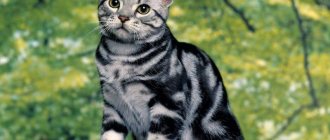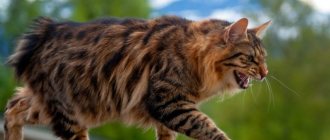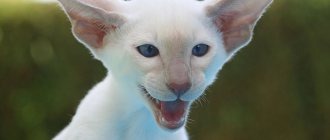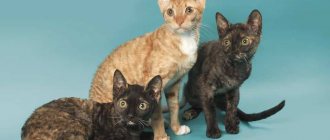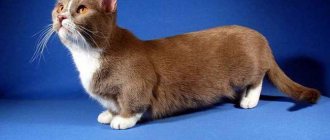| MOSCOW ORIENTAL CATTERY | |||||||
| Photo album | Kittens for sale | Litters | Links | ||||
| Home | Females | Photo album | Kittens for sale | Litters | Links | ||
The color of a cat, like other information about its body, is written in its genes. A gene is the elementary unit of heredity. The number of genes is huge, each gene is responsible for some feature of the organism (or group of features). Many genes interact: one property is controlled by several genes.
Allelic genes, or alleles, are different forms of the same gene that determine development options for the same trait. Each gene has at least two possible forms (often more). One of the allelic genes is dominant relative to the other (recessive). Dominance means that the dominant allele suppresses the effect of another (recessive) allele. As a result, the offspring develop a trait controlled by a dominant gene.
Each parent passes on to their offspring one gene responsible for each characteristic of the body. If at least one of the two genes in this pair is dominant, then this trait will appear visually. A recessive gene manifests itself externally only when a recessive gene is received from each parent.
If both genes in a pair are the same, then the cat will be homozygous for this trait; if the genes are different, then it will be heterozygous. In a heterozygous individual, only a dominant trait is externally manifested, but the animal carries a hidden recessive trait, which can appear in the offspring of a given cat - if a recessive gene “meets” another recessive gene, then some of the descendants may also externally manifest a recessive trait, although in he did not appear to his parents outwardly.
Let's look at all this using the example of Siamese and non-Siamese colors. These photos show two kittens.
This is an oriental cat, color - black (ORI n), she has a dominant gene. | This is a Siamese kitten, seal point color (SIA n), he has a recessive gene. |
In Siamese cats, only the protruding tips of the body (points) are intensely colored - the muzzle, ears, paws and tail, while the body remains light. The Siamese color is sometimes also called “point”, i.e. final. The opposite option is non-Siamese coloring, when the entire body, muzzle, and paws of the animal are colored the same. Those. Orientals are solid colored Siamese cats.
Gene names are written in Latin letters, with large letters indicating dominant alleles and small letters indicating recessive ones. The gene that is responsible for the Siamese color variation is designated cs, the gene for non-Siamese, i.e., oriental color is C.
The cs gene is recessive to the non-Siamese color gene C, i.e. it appears outwardly only if both the father-cat and the mother-cat have each passed on one cs gene to their kitten. Only if two cs genes are combined in one kitten, such a kitten will be Siamese in color.
The non-Siamese color gene C is a dominant gene; its effect is manifested visually in any case, regardless of which second gene responsible for the same trait was passed on to the kitten by the second parent. The second gene can be both dominant and recessive. In this case, parents can be of different colors, including both of them can be completely colored. Those. Two Orientals can have a Siamese if both parents are carriers of the Siamese cs gene.
When we see a cat of non-Siamese color, we see the manifestation of the dominant gene C. At the same time, the second gene in this cat may also be C, and this does not change anything, but it may also be recessive - cs. Then this cat is oriental in appearance, but is a carrier of the Siamese color gene. If a cat has both cs+cs genes, then it will definitely have a Siamese color.
Here is a table of possible combinations of the C and cs genes received by a kitten from its parents; there are only six different combinations. Both parents may or may not be carriers of the Siamese gene:
| Combination of parental genotypes (inheritance of the Siamese gene does not depend on gender) | Kittens that can be born from these parents | ||
| 1st parent (genotype and appearance) | 2nd parent (genotype and appearance) | Genotype | Appearance |
| C+C Oriental without Siamese gene | C+C Oriental without Siamese gene | all kittens: C+C, orientals without the Siamese gene | all kittens are oriental |
| C+C Oriental without Siamese gene | C+cs oriental, carrier of the Siamese gene | 50% of kittens: C+C orientals without the Siamese gene | all kittens are oriental |
| 50% of kittens: C+cs orientals, carriers of the Siamese gene | |||
| C+C Oriental without Siamese gene | cs+cs siam | all kittens: C+cs orientals, carriers of the Siamese gene | all kittens are oriental |
| C+cs oriental, carrier of the Siamese gene | C+cs oriental, carrier of the Siamese gene | 25% of kittens: C+C orientals, do not have the Siamese gene | 75% of kittens: orientals |
| 50% of kittens: C+cs orientals, carriers of the Siamese gene | |||
| 25% of kittens: cs+cs siamese | 25% of kittens: Siamese | ||
| C+cs oriental, carrier of the Siamese gene | cs+cs siam | 50% of kittens: C+cs orientals, carriers of the Siamese gene | 50% of kittens: orientals |
| 50% of kittens: cs+cs siamese | 50% of kittens: Siamese | ||
| cs+cs siam | cs+cs siam | all kittens: cs+cs siamese | all Siamese kittens |
The table shows, for example, that when mating two Orientals - carriers of the Siamese color gene, out of four kittens, three will be Orientals, and one will be a Siamese. At the same time, one of the three Orientals will be homozygous for this trait, and they will not have the recessive cs gene. Two Oriental kittens will be heterozygous for the C gene, i.e. they will be carriers of the Siamese color. The offspring of these animals may include Siamese.
However, this ratio can only be seen with a large number of kittens (for example, 100 kittens). And since the number of kittens in a litter is small - from 1 to 8, this distribution of the number of kittens happens quite rarely. It may turn out that in one litter from Orientals - carriers of the Siamese color - all kittens will be born non-Siamese, and in another - half of the kittens will be Siamese, etc.
Understanding whether a non-Siamese animal is a carrier of the cs gene is simple in some cases, but quite difficult in others. If one of the animal's parents is Siamese, this animal is definitely a carrier of the Siamese gene. If Siamese-colored kittens were born from this animal, the same thing. But to say the opposite - that some animal of externally non-Siamese color is NOT a carrier of the Siamese gene - is difficult. This can be said with certainty only if two conditions are met:
- for several generations of the pedigree there was not a single animal of Siamese color;
- Siamese kittens have never been born from this animal.
You should always remember that a pair of genes responsible for one trait is inherited independently of other pairs of genes responsible for other traits. For example, the inheritance of the primary coat color (red or black) is absolutely independent of the inheritance of the color type - Siamese or non-Siamese.
The resulting color of a cat depends on the combination of genes responsible for various traits.
For example, if a cat has the black color gene BB (or Bb) + the pattern gene AA (or Aa) + the spotted pattern gene TT (Ttb) + the silver gene Ii (Ii), then its color is black spotted silver.
If a cat has the black gene BB (or Bb) + the gene for the absence of a pattern aa + the gene for the absence of silver ii, then its color is solid black, etc.
The number of such combinations is quite large. This is why cats come in such a variety of patterns and colors.
Let's look at the genes responsible for the colors that are most often found in Orientals:
| Designation | The trait for which this gene is responsible | Variants (alleles) | Peculiarities |
| W | White or off-white coat color | W - white color w - non-white color | Dominant white suppresses all other colors and patterns |
| O | Red or non-red coat color | O - red (cream) color o - non-red color (black, chocolate, blue) | Red and cream colors suppress all other colors except white (i.e. suppress black, chocolate, blue) |
| B | Black coat color | B - black color b - chocolate color b1 - cinnamon | Black color suppresses chocolate and cinnamon, chocolate suppresses cinnamon |
| D | Bright or lightened coat color | D - bright color d - lightened color | Any bright color suppresses the corresponding light color, for example, black suppresses blue |
| A | Presence or absence of a pattern on the fur | A - there is a picture a - there is no picture | The pattern suppresses the smooth color |
| T | Type of pattern on wool | Ta - ticking T - brindle (spotted) pattern tb - marbled pattern | Ticking suppresses stain, stain suppresses marble |
| C | Siamese or non-Siamese color | C - non-Siamese color (oriental) cs - Siamese color | Non-Siamese color suppresses Siamese color |
| I | Silver (smoke) or no silver (smoke) | I - there is silver i - there is no silver | Silver color suppresses non-silver color |
| S | White spots (bicolor) or no white spots | S - white spots (bicolor) s - color without white spots | The white spot gene is dominant |
Primary (solid, solid) colors
The color of fur and eyes depends on the presence of melanin, which has two chemical varieties: Eumelanin (eumelanin) and Phaeomelanin (phaumelanin). Eumelanin gives black pigmentation, Phaeomelanin gives red pigmentation. Therefore, all cat colors are based on two colors - black and red. The coat color gene forms the main colors in the absence of the dominant allele of the pattern A gene.
Coat color genes are divided into three subgroups:
- Black gene, possible alleles:
- B - black color (ebony);
b - brown (chocolate, Havana, chestnut);
- b1 - light brown (cinnamon, cinnamon).
- The gene for red color is dominant over black:
- O - red;
- o - non-red, only in this case the black color and its varieties appear.
- The intensity gene, the saturation of coat color, has two variants:
- D - bright color (black, chocolate, red);
- d - lightened color (blue, purple, cream).
Black color is dominant to brown, brown to light brown.
black | chocolate | lilac |
The combination of these three genes: red-non-red O, black B and intensity D form 8 main colors, presented in the table:
| Color | Intensity, color saturation | |
| Maximum saturation - bright color (dominant) | Minimum saturation - lightened color (recessive) | |
| Red (Phaeomelanin manifested) | red | cream |
| Black (Eumelanin manifested) | black | blue |
| chocolate | lilac | |
| cinnamon (cinnamon) | faun (fawn) | |
Dominance goes from left to right and from top to bottom: red suppresses black, black suppresses chocolate. Any bright color suppresses the corresponding lightened one.
The specificity of the O gene (red-non-red) is that it is associated with the X chromosome, i.e. depends on gender. Cats have two X chromosomes, each chromosome can contain either O - red, or O - non-red. If both X chromosomes carry the red O gene, such a cat will be red. If both X chromosomes carry the non-red gene o, then the cat will be black. If one chromosome carries the O gene and the other carries the O gene, then part of the coat will be red and part will be black, and the cat will be motley. This color is called “tortoiseshell”.
More about tortoiseshell color
Cats have only one X chromosome, and accordingly, only one O gene. Therefore, a cat can be either red or black; there are no tortoiseshell cats. More precisely, they do occur, but this is a very rare phenomenon, a genetic deviation, and such animals are sterile.
Possible solid colors of kittens depending on the color combination of the parents are shown in the table:
| Father cat | |||
| Red (cream) | Black (chocolate, blue, lilac) | ||
| Mother cat | Red (cream) | All kittens are red (cream) | Cats: turtles Cats: red (cream) |
| Black (chocolate, blue, lilac) | Cats: turtles Cats: black (chocolate, blue, lilac) | All kittens are black (chocolate, blue, lilac) | |
| Turtle | Cats: red and turtles Cats: black (chocolate, blue, lilac) and red (cream) | Cats: black (chocolate, blue, lilac) and turtles Cats: black (chocolate, blue, lilac) and red (cream) | |
This table shows the main colors for kittens - red and black, with lightened options in brackets (blue, lilac, cream). We should not forget that lightened variants are inherited regardless of the main color. Those. If these parents can produce a black kitten, they can also produce a blue, chocolate or lilac kitten, depending on the presence and combination of the parental black-chocolate and bright-bleached genes. If a red kitten can be born, then a cream one can be born (again, if both parents have the lightening gene).
Inheritance of bright-lightened color occurs according to the usual “dominant-recessive” pattern, similar to the inheritance of Siamese-non-Siamese color.
black | blue |
Table of possible combinations of parental genotypes for genes D and d
Also, according to the “dominant-recessive” scheme (and, moreover, regardless of the bright-lightened color), variants of the same gene are inherited, for example, black (B) and chocolate (b) coat color.
black | chocolate |
Table of possible combinations of parental genotypes for genes B and b
Inheritance will be the same for other pairs of alleles of the B gene: B and b1, b and b1 - according to the same “dominant-recessive” pattern.
Character
The Oriental cat really needs attention. The owners may slightly dislike their excessive energy. Because this cat won't let you get bored. He is very active, loves to play with everything that comes under his paw, chasing toys and even dust.
A cat under the age of six months will constantly need to be taken out of cabinets, curtains, in general, from anywhere he can climb. Sometimes it even seems that he can walk on the ceiling.
They are curious and very smart, so training Oriental cats can and even should be done from a very young age.
The character of the Oriental cat is very touchy. Without receiving much attention and care, she can easily become sad and depressed. Animals are not shy about expressing their character, and can cause mischief if something doesn’t suit them.
Pattern genes: agouti and tabby
The agouti gene A controls the possibility of the appearance of a pattern on six, i.e. stripes, spots of various shapes, as well as ticking - Abyssinian color. Allele A is dominant - there is a pattern, allele A is recessive - there is no pattern, the cat has a solid coat color. The natural color of a wild cat is a patterned coat, while the smooth, solid colors are artificially bred.
| black spotted | black smooth |
Inheritance of the agouti A gene (there is a pattern, there is no pattern) occurs according to the usual “dominant-recessive” pattern, similar to the inheritance of Siamese-non-Siamese color.
Table of possible combinations of parental genotypes for genes A and a
Often in cats of solid colors you can notice a barely noticeable tabby pattern. This is acceptable for kittens and adolescents; with age, the residual pattern should disappear. The reason for the appearance of a light pattern is that every animal carries some kind of pattern gene - spotting, marbling or ticking. But in the presence of gene a (“non-agouti”) the pattern is suppressed; it is not visible, but is present in the genotype of the animal. If you breed a smooth-colored animal with a tabby partner, the pattern will appear.
The Tabby T gene determines what specific pattern a cat's coat will have—striped, spotted, marbled, or ticked. All types of patterns have stripes on the face, paws and tail. There is a characteristic pattern in the form of the letter “M” on the forehead; clear stripes of solid color run from the outer eyes of both eyes to the cheeks.
The T gene has the following variants:
- Abyssinian (ticked) tabby Ta: the body is without stripes and spots, each hair is ticked - dark and light areas on it alternate, so that the coat looks like freckles, speckled.
- Brindle Tabby T - narrow vertical stripes on the sides, clear and numerous. The spotted tabby is genetically the same as the brindle, but the stripes are broken into separate spots. There is no specific gene for spotting, or it is unknown. In cats of the Oriental breed, the spotted color is much more common than the brindle color.
- Marbled, or classic tabby tb: the cat has beautiful stripes on the sides in the form of horizontal loops (“bull’s eyes”) and a “butterfly” on the back. The pattern resembles marble stains.
black ticked | black spot |
black marble | The Abyssinian tabby Ta is dominant over the brindle (spotted) tabby T, the brindle (spotted) tabby is dominant over the marbled tabby tb. Those. It is quite easy to get a ticked or spotted animal, but getting a marbled pattern is possible only from two animals - carriers of the tb allele. Inheritance of the T gene, which determines the type of pattern, occurs according to the usual “dominant-recessive” pattern, similar to the inheritance of Siamese-non-Siamese color. |
Table of possible combinations of parental genotypes for the T(spot) and tb(marble) genes
Inheritance will be the same for other pairs of alleles of the T gene: Ta and T, Ta and tb - according to the “dominant-recessive” scheme.
Genes can influence each other. For example, the O - “red” gene is not affected by the a allele (“non-agouti”, lack of pattern on the coat). Therefore, all cats of red (and cream) colors always have a tabby pattern on their coat (stripes, spots or ticking), regardless of which version of the agouti gene the cat has - A or a.
Those. if a cat has the genotype AA OO TT, then it is genetically an “agouti”, a cat with a pattern. And a cat with the aa OO TT genotype is genetically “non-agouti”, a cat without a pattern, but outwardly both cats look the same.
Some breeders produce red and cream cats that appear solid in color - this is why they choose to breed animals with patterns of reduced contrast. However, the letter “M” on the forehead of such cats is still present.
History of the origin of the breed
The name can be translated from English as “eastern”. But the Oriental breed has a huge and branchy family tree.
For the first time, the oriental cat was mentioned in the Thai manuscript “Book of Poems about Cats” in 1358. For a long time, the East did not allow the export of the Oriental breed from the country, which did not allow the world to know about it. Fortunately, in the 19th century, a couple of cats were taken to the New World.
Oriental cats were presented at an exhibition in London in 1994, but did not gain popularity. They have been praised by critics as brown Siamese cats with blue-green eyes.
Oriental Siamese tried their luck two years later, or rather at a British exhibition. But this time they did not receive universal love, since they were disqualified because of their color.
For a long time, the peculiarities of the Oriental cat breed prevented it from ascending to the pedestal. The entire appearance of these cats led experts astray. For a long time they wanted to ban the breeding of Orientals, mistaking them for “non-Siams”.
But in the 60s, breeders decided to try to cross the Siamese with the Oriental cat. So in 1974, a new Oriental cat breed was created.
Silver and smoke
Silver tabby is a dark pattern (marble, spot) on a white, sort of silvery background. Smoke is a solid color version of the silver tabby. This color looks like the main color, but the roots of the hair are white. When you blow on the fur, a contrasting white undercoat is visible. This is also noticeable when the animal moves.
Silver and smoke are dominant colors, i.e. a kitten with silver can only be born if one of the parents has silver or smoke. The silver (smoke) gene is designated I.
Table of combinations of parental genotypes for gene I
Diseases of Orientals
Orientals for the most part are fairly healthy animals, without genetic diseases, with a fairly strong immune system. This is probably due to the fact that the Oriental cat is quite young, and its genetics includes representatives of different breeds.
But there are still several diseases that spoil the overall health picture of Orientals. This:
- heart failure (cardiomyopathy);
- flat chest (breathing becomes difficult, the diaphragm is disrupted and the heart is compressed);
- retinal atrophy;
- liver amyloidosis (protein metabolism disorder);
- gingivitis.
Oriki are also susceptible to colds and other diseases associated with hypothermia (for example, otitis media).
With proper care and quality nutrition, your Oriental cat can live 15–18 years.
Dominant white
The dominant white W gene suppresses all other color genes - red, black, pattern, etc. However, underneath the white coat there are recessive genes for other colors and patterns, so white cats can have both white and non-white kittens. Many white kittens have a spot on their head that reveals their hidden recessive color. With age, this spot disappears.
Table of combinations of parent genotypes for the W gene
white with green eyes | white odd-eyed | foreign white: white with blue eyes |
More about white color
Caring for Oriental cats
Oriental cats need regular care. But fortunately, it is very simple.
- To keep the fur in order, you need to comb it once a week with a special rubber glove.
- Although Oriental cats do not really like ear cleaning, they cannot do without it. It is carried out with cotton swabs.
- Teeth must be kept clean; stone removal takes place in a veterinary clinic.
- We must not forget about the prevention and removal of worms and fleas, as they are harmful not only to cats, but also to humans.
- It is necessary to keep an eye on your oriental cat's nails and trim them. This procedure is usually performed by a veterinarian, but you can do it yourself without any problems.
Caring for Oriental kittens is no different from caring for adults.
What to feed an Oriental cat
These cats love to eat and are not worried about their figure. But they are prone to obesity, so feeding an Oriental cat can sometimes become a problem for the owner.
Breeders recommend purchasing premium food. But not everyone is ready to feed their pet canned food. Therefore, it is worth knowing that he needs fats. So for each serving you need to add a small piece of butter to the main dish.
Tips for choosing a kitten
Purchasing a kitten should only be done from trusted breeders or nurseries with a good reputation. The following must be taken into account:
- the kitten must be at least 3 months old;
- All documents must be present: birth certificate or pedigree, veterinary passport indicating the vaccinations;
- cats and kittens must be kept in good conditions;
- the appearance and behavior of the parents fully meet the requirements of the breed standard.
Observe the kitten, examine it: some isolation is allowed if the animal was kept in a cage. In any case, outwardly the baby should not raise any questions regarding health: there should be no inflammation, tumors, runny nose or other manifestations of a painful condition.
Who is not recommended to have an ori?
The Oriental breed is a companion cat. If you disappear all day at work, then it will be difficult for them to endure regular loneliness. It is undesirable to take an Oriental into a house where there are already animals: this can lead to a conflict due to the “redistribution of zones of influence.” The Oriental will fight for the owner's attention, creating a tense situation over and over again.
Nutrition
The Oriental has a sensitive digestive system, so it is preferable to feed it with premium or super premium store-bought food.
If an Oriental cat eats natural food, then its diet includes:
- lean meat;
- offal;
- fish (2 times a week);
- eggs (2 times a week);
- vegetables (mixed into main food);
- fermented milk products.
A sudden change in diet is unacceptable. It will negatively affect the animal's digestion. Kittens eat 4-5 times a day. An adult animal is given food 2 times. In order not to provoke obesity in the Oriental, you should not give him more than 300 kcal per day.
Interesting Facts
One of the main factors influencing the choice of breed is hypoallergenicity. In addition, Oriental cats hide many secrets that potential owners will be interested to know about:
- due to the incredible number of colors, Orientals are often called rainbow cats;
- due to the lack of undercoat, they cannot be kept like ordinary yard animals;
- the breeds in which genetic pathologies are almost completely absent can be counted on one hand - and Orientals are also on this list;
- good living conditions will ensure that your beloved pet stays next to its owner for up to 20 years - this is a long-lived breed;
- before registration, the Oriental breed was called one-color coffee Siamese;
- constant need for tactile contact, loud meowing in the absence of it;
- jealousy, sometimes completely unfounded - towards a thing, toy or piece of furniture;
- there are cats with obvious strabismus, for which they can be excluded from participation in exhibitions and breeding work;
- reluctance to use claws;
- devotion to the owner is akin to that of a dog;
- voice timbre atypical for most representatives of the cat family.
One of the most interesting facts is the tendency to copy the actions of the owner. Because of this habit, it is sometimes easier to teach an Oriental cat to use the toilet than the tray intended for it.



